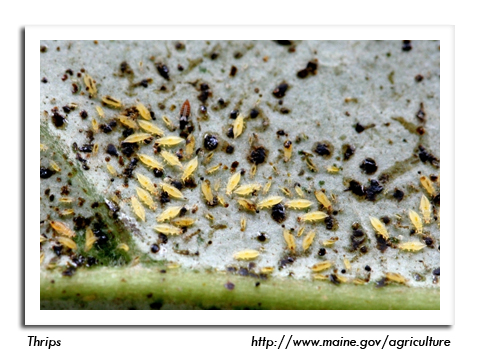
 |
|
|
Nursery & Forest
Volume 59 Number 3 Date 05/15/2014 VIRUSES - Nursery inspectors report finding relatively few pests during early-season greenhouse and garden center inspections, with the exception of plant viruses, which continue to be a common problem again this season. The viruses observed this week, and host plants infected, were as follows: cucumber mosaic virus (CMV) on aconitum 'Carmichaelii arendsii', astilbe 'Fanal', 'Stand and Deliver', delphinium 'Black Knight', and phlox 'Blue Flame'; impatiens necrotic spot virus (INSV) on begonia 'non-stop yellow', Maltese cross 'Orange Gnome' and on wax plant; wisteria vein mosaic potyvirus on wisteria 'Blue Moon'; tobacco rattle virus (TRV) on astilbe 'Red Sentinal', dicentra 'Pink', 'White' and barrenwort 'Red Bishop's hat'; and tobacco mosaic virus (TMV) on petunia 'Blue Wave', 'Orange Flash', 'Poppy Red' and 'Sunflower Ray'. Although viruses rarely kill plants, they sometimes dramatically alter plant appearance and can greatly reduce the value of ornamentals. Control of virus diseases is a matter of prevention, including the use of virus-free planting and propagating stock. Diseased nursery plants should be removed and disposed of early in the season. SPIDER MITE - Damage attributed to these minute arthropods was observed on echinacea 'Southern Belle', mandevilla and sweet potato vine at greenhouses in Ozaukee and Pierce counties. Symptoms of injury vary by species of mite and the host plant being attacked, but usually include stippling, bronzing and mottling of the upper leaf surface. The species most commonly found in greenhouse settings are the two-spotted spider mite and cyclamen mite. Control of these mites and others relies upon an understanding of their biology, so distinguishing between mite species is critical. THRIPS - DATCP inspectors also noted thrips injury on dahlia, gazonia, gerbera, osteospermum 'Akila White' and verbena at garden centers in Ozaukee and Washington counties. Thrips feeding results in stippled, silvery or bleached foliage and, in severe cases, yellowing and leaf drop. Due to their small size, thrips are often difficult to detect until feeding damage has become severe. As with spider mites, control requires accurate identification of the species involved. -- Ellen Hermanson, DATCP Nursery Inspector EMERALD ASH BORER - The green symbols in the map below represent the approximately 1,500 EAB traps being set by DATCP, DNR and the USDA-APHIS in 2014. Detection trapping will be conducted in campgrounds, recreation areas, major transportation arteries, sawmills and other high-risk locations statewide, with an emphasis on the 52 counties in which EAB has not yet been found. The purple panel traps are baited with an attractant and have a sticky exterior to capture EAB adults. The beetles are expected to begin emerging from beneath the bark of ash trees when 350 and 450 degree days (base 50°F) have accumulated, or by June 1 in far southern Wisconsin and about one month later in the northern counties. Placement of the purple panel traps is scheduled to start next week. -- Renee Pinski, DATCP Forest Entomologist CHILLING INJURY - A variety of ornamental plant samples showing symptoms consistent with chilling injury have been submitted to the Plant Industry Bureau Laboratory for testing this spring. Delphinium and petunia samples with mottled and chlorotic leaves, speedwell with dwarfing and distortion, and a slow-growing vinca are among the plants received. Plant chilling injury refers to a physiological disorder caused by low temperature stress in the absence of freezing. Symptom expression varies by plant species, as does the range of temperatures at which chilling can occur. Symptoms may appear as leaf spots, mottling or chlorosis, delayed growth, or bud abortion. Buds and young leaf tissues are most sensitive and can emerge puckered and distorted, or with necrotic spots. Although injury may persist for several weeks after chilling has occurred, most plants outgrow the symptoms and eventually resume normal development. -- Anette Phibbs, DATCP Plant Pathologist 




|
|
|